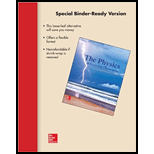
(a)
The speed of the car with which the riders are moving in the Ferris wheel, If the radius of the wheel is
(a)
Answer to Problem 2SP
The speed of the car with which the riders are moving is
Explanation of Solution
Given Info: The radius of the curve is
Write the equation for the speed with which the riders are moving.
Here,
The time period is the time taken for an object to complete one rotation. Therefore the time period of rotation of the riders is
Substitute
Conclusion:
Thus the magnitude of the centripetal acceleration of the car is
(b)
The magnitude of the centripetal acceleration for the circular motion of the Ferris wheel.
(b)
Answer to Problem 2SP
The magnitude of the centripetal acceleration for the circular motion of the Ferris wheel is
Explanation of Solution
Given Info: The radius of the Ferris wheel is
Write the equation for centripetal acceleration.
Here,
Substitute
Conclusion:
Thus, the centripetal acceleration of the circular motion is
(c)
The magnitude of the
(c)
Answer to Problem 2SP
The magnitude of the centripetal force required to keep a rider moving in a circle is
Explanation of Solution
Given Info: The mass of the rider is
Write the expression for the magnitude of centripetal force.
Here,
Substitute
The centripetal force required to keep the rider in the circular path is
At the top of the cycle the weight of the body can give this centripetal force, if the weight is equal to or greater than the centripetal force. If the weight of the body is less than centripetal force the motion, the weight cannot provide centripetal force.
Write the expression for the weight of the body.
Here,
Substitute
Since the weight of the rider is greater than the centripetal force, weight can give provide centripetal force required for the circular motion.
Conclusion:
Thus, the magnitude of the centripetal force required to keep a rider moving in a circle is
(d)
The magnitude of the normal force exerted by the seat on the rider at the top of the cycle.
(d)
Answer to Problem 2SP
The magnitude of the normal force exerted by the seat on the rider at the top of the cycle is
Explanation of Solution
Given Info: The mass of the rider is
The weight of the rider is
Since the rider is accelerates towards the center of the circle, the net force is the centripetal force acting towards the center.
Write the expression for the net force on the rider.
Here,
The negative sign in the above equation indicates that the weight of the rider and the normal force are opposite in direction.
Rearrange the above equation to get
Substitute
Therefore the normal force acting on the rider by the seat at the top of the wheel is
Conclusion:
Thus, the magnitude of the normal force exerted by the seat on the rider at the top of the cycle is
(e)
State of the rider if the Ferris wheel is going so fast that the weight of the rider is not sufficient to provide the centripetal force at the top of the cycle.
(e)
Answer to Problem 2SP
The rider will fly out at a trajectory tangent to the Ferris wheel because, the weight of the rider not sufficient to provide the centripetal force.
Explanation of Solution
The centripetal force required to hold the rider in circular motion in Ferris wheel of radius
Write the expression for the centripetal force.
The above expression implies that the centripetal acceleration is directly proportional to the square of the speed of the rider.
Therefore, if the speed of the rider is very fast then centripetal force will be also very large. In such case weight of rider cannot supply enough centripetal force to the rider. This will cause imbalance in the net force and the rider will fly out from the seat.
If there are safety measures then it will give enough force to avoid outward push. If safety measures are not available then the rider will fly out in tangential direction.
Conclusion:
Thus, if the weight of the rider is less compared to the centripetal force, then the rider will fly out in the tangential direction because the absence of any force to provide the centripetal force.
Want to see more full solutions like this?
Chapter 5 Solutions
Physics of Everyday Phenomena (Looseleaf)
 College PhysicsPhysicsISBN:9781305952300Author:Raymond A. Serway, Chris VuillePublisher:Cengage Learning
College PhysicsPhysicsISBN:9781305952300Author:Raymond A. Serway, Chris VuillePublisher:Cengage Learning University Physics (14th Edition)PhysicsISBN:9780133969290Author:Hugh D. Young, Roger A. FreedmanPublisher:PEARSON
University Physics (14th Edition)PhysicsISBN:9780133969290Author:Hugh D. Young, Roger A. FreedmanPublisher:PEARSON Introduction To Quantum MechanicsPhysicsISBN:9781107189638Author:Griffiths, David J., Schroeter, Darrell F.Publisher:Cambridge University Press
Introduction To Quantum MechanicsPhysicsISBN:9781107189638Author:Griffiths, David J., Schroeter, Darrell F.Publisher:Cambridge University Press Physics for Scientists and EngineersPhysicsISBN:9781337553278Author:Raymond A. Serway, John W. JewettPublisher:Cengage Learning
Physics for Scientists and EngineersPhysicsISBN:9781337553278Author:Raymond A. Serway, John W. JewettPublisher:Cengage Learning Lecture- Tutorials for Introductory AstronomyPhysicsISBN:9780321820464Author:Edward E. Prather, Tim P. Slater, Jeff P. Adams, Gina BrissendenPublisher:Addison-Wesley
Lecture- Tutorials for Introductory AstronomyPhysicsISBN:9780321820464Author:Edward E. Prather, Tim P. Slater, Jeff P. Adams, Gina BrissendenPublisher:Addison-Wesley College Physics: A Strategic Approach (4th Editio...PhysicsISBN:9780134609034Author:Randall D. Knight (Professor Emeritus), Brian Jones, Stuart FieldPublisher:PEARSON
College Physics: A Strategic Approach (4th Editio...PhysicsISBN:9780134609034Author:Randall D. Knight (Professor Emeritus), Brian Jones, Stuart FieldPublisher:PEARSON





